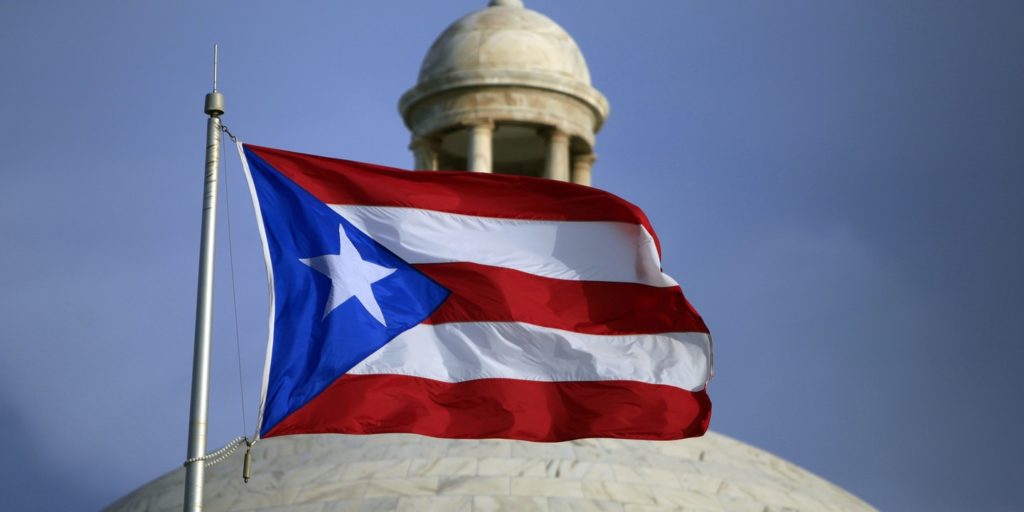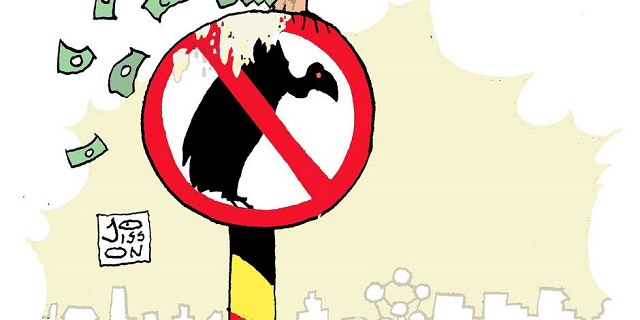Vulture Funds Stand to Make Millions in Wake of Hurricane Maria
ANGLO AMERICA, CAPITALISM, 1 Oct 2018
28 Sep 2018 – Vulture funds scooped up hundreds of millions of dollars worth of Puerto Rican debt after Hurricane Maria hit — underwritten by Wall Street and purchased at a massive discount, according to new numbers compiled by the nonprofit LittleSis and provided to The Intercept.
Now it’s time for the payoff. A deal agreed to last week between creditors, the Puerto Rican government and the Washington-appointed fiscal control board overseeing the island’s finances could now funnel hundreds of millions of dollars to those same bondholders in the coming decades. There’s also ample reason to suspect at least some of those funds will be siphoned from federal recovery dollars, intended to help rebuild after the storm.
According to court filings made public as a result of ongoing debt negotiations, several hedge funds have bought up massive amounts of Puerto Rican bonds in the year following Hurricane Maria, after which prices dropped. GoldenTree Asset Management, a bondholder for the Urgent Interest Fund Corporation — known by its Spanish-language acronym COFINA — owned $587 million worth of Puerto Rican government bonds before the storm, as noted in a filing dated August 18, 2017. As of another filing almost exactly a year later, the company owned $1.5 billion.
Tilden Park Capital Management, another COFINA creditor, increased the value of its holdings by $370 million over the same period. General obligation bondholders Aurelius Capital Management and Monarch Alternative Capital have increased their holdings from $39 million before the storm to $488 million as of the last filing. (Aurelius and Monarch both also hold some COFINA bonds.)
Due to complexities in the ways some bonds are valued, some hedge funds are reporting increases in bond holdings without actually purchasing more debt. Those bonds, called capital appreciation bonds, have been referred to as Puerto Rico’s payday loans due to their predatory structure, in which interest is added back to principal, which increases exponentially over time. In the cases of GoldenTree, Tilden Park, Monarch, and Aurelius, the increases in reported holdings are so massive that they appear to be due to new purchases of debt.
As In These Times noted in its analysis of these court filings last year, Tilden Park Chief Investment Officer Joshua Birnbaum is no stranger to profiting off crises. He made $3.7 billion for Goldman Sachs in 2007 by shorting the subprime mortgage market. Birnbaum got a $10 million bonus for the feat, but — unsatisfied — left the following year to start Tilden Park. “If you’re a steelworker, you probably think I got paid pretty well,” he told the Financial Times of his Goldman departure. “If you’re a hedge fund manager, you probably don’t.”
By virtually any metric, Birnbaum stands to make a killing on Puerto Rico.
The fiscal control board, COFINA bondholders, and the island’s government had already agreed to a restructuring package for COFINA debt — comprising around a quarter of the island’s total debt obligation — that led bond prices to rally early in the summer after another boost in early spring. Under the agreement, senior creditors will see a 93 percent payout on the face-value of the bonds and junior creditors will see a 56 percent payout. Last Friday — after fierce legal battles — general obligation creditors agreed to a slightly amended version of the deal. The final decision will now be up to Judge Laura Taylor Swain, of the U.S. District Court for the Southern District of New York, who presides over the ongoing bankruptcy-like negotiations between Puerto Rico and its creditors. Today, it was announced that Swain will hear the case by October 15.

The Puerto Rican flag flies in front of Puerto Rico’s Capitol in San Juan on July 29, 2015.
Photo: Ricardo Arduengo/AP
Should the deal pass muster there, it would see the island return $33 billion to creditors on a principal of just $17.5 billion. Based on a review of bond prices and increases in reported holdings, Kevin Connor of LittleSis estimates that GoldenTree and Tilden Park could make a 100 to 150 percent profit on COFINA subordinate debt purchased after prices slumped in the wake of the hurricane — or around $200 million to $300 million in pure profit on a $200 million investment. Including debt purchased before the hurricane, their combined profits are likely well above $500 million.
While news of the deal has been heartening to investors, economist Martin Guzman says it’s out of touch with realities on the island. “The key driver of the [general obligation] and COFINA bonds price escalation has been the expectation of a much larger recovery than what market prices reflected by then, founded in the Board’s, US Congress’, and Puerto Rico’s government positions and actions–that are overall not aligned with what Puerto Rico’s recovery requires,” he told The Intercept via email. “The COFINA deal will jeopardize the recovery of Puerto Rico’s debt sustainability,” which he, Joseph Stiglitz, and Pablo Gluzzman conducted a detailed analysis on this winter. “If COFINA bondholders get what this deal entails, the entire stock of remaining debts should be written-off in order to achieve the necessary relief for restoring debt sustainability.”
Not counting pension obligations, Puerto Rico is estimated to be saddled with about $74 billion total in municipal debt. While it’s proven a gold mine for vulture funds, Wall Street banks and consultants, significant payments on the debt will ultimately come at the expense of rebuilding Puerto Rico’s economy — both from the storm and from the over a decade long depression on the island.
COFINA bonds were designed principally by big banks to skirt Puerto Rico’s borrowing limit, allowing the island to sell off more bonds and for the banks to scrape millions off the top in underwriting fees. Repayment on COFINA bonds is pegged to sales tax, meaning the 11.5 percent sales tax Puerto Ricans pay — higher than any on the U.S. mainland — is legally claimed by bondholders.
“It’s a direct transfer of wealth out of a situation where there’s a deep crisis,” Connor told me by phone. “Instead of that being addressed, money is being used to line pockets of vulture funds. The payouts promised in this deal are insanely high and basically portend more social and economic crisis.” He adds that the bullishness in the bond market triggered by the deal’s announcement is “inflating a bubble of expectation around this crisis that will not be sustainable. They inflate the market for this debt, vultures sell out of their positions before they crash and then the cycle begins again.”
It’s hard to understand much of anything happening in Puerto Rico — officially a commonwealth of the United States — without some context in its recent and even colonial history, as the story of the island’s massive debt is deeply interwoven with its lack of sovereignty. To abridge that considerably: Puerto Rico’s economy had been growing fairly steadily through the time when a series of generous federal tax breaks for corporations operating on the island expired in 2006. Combined with free trade deals like NAFTA, that made it a less desirable locale for U.S.-based corporations to invest since they could now more easily relocate to places with lower labor and environmental standards.
The economy began to decline shortly thereafter and got hit again with the onset of the global financial crisis. Starting in 2009 the local government enacted a series of austerity measures that dwindled the tax base further and deepened the crisis. Because Puerto Rico isn’t a sovereign country, it can’t rely on either monetary policy or adjustments to its exchange rate to bring in more cash, so turned to bond markets. By that point, Puerto Rican debt wasn’t a particularly attractive investment given the island’s prolonged economic crisis and dim prospects for recovery, so the island tried to sweeten the deal by making them “triple tax exempt” — free from local, state, and federal taxes.
That’s when vulture funds — and the Wall Street banks eager to underwrite their bond sales — stepped in.
Vulture funds are hedge funds, or any other private commercial entities, that buy up public debt made cheap by some crisis or another — a hurricane, an economic crash, etc. — and then litigates aggressively with those governments to extract as much as possible in repayment. The most famous example of how they work in practice has played out over the last decade and a half in Argentina. A small handful of funds scooped up sovereign debt for pennies on the dollar following a major economic crisis in the country, continued to aggressively litigate with the government there — even after the majority of bondholders had reached a settlement — and then extracted huge returns as they successfully demanded that the country repay them the face value of the bond plus sky-high interest payments. One firm, NML Capital, saw a 1,200 percent, or $2 billion, return on investment.
Unlike Argentina, Puerto Rico isn’t sovereign. And after well over a decade of steep economic decline, the island has basically no capacity to “service,” pay back, its debt. Congress passed a law in 2016, known as the Puerto Rico Oversight, Management, and Economic Stability Act, to restructure that debt and place economic life under the control of a Washington-appointed fiscal oversight board, known locally as “La Junta.” It’s also Title III of PROMESA which outlines the bankruptcy-like court process now playing out in New York.
Whether this debt is even legal remains a subject of some controversy. There have been frequent, largely unheeded pushes from social movements in Puerto Rico to conduct a full and independent audit of the debt to determine just how much of it is legitimate. Shortly after current Gov. Ricardo Rosselló took office in January 2017, he disbanded the government agency charged with auditing the debt, declaring at the time that, “declaring a debt illegal does not mean it doesn’t have to be paid.”
While the board has lauded the COFINA deal as a major step forward in the restructuring process, it’s still not clear where the money to make good on it will come from. The most recently approved fiscal plan for the island projects that by 2058, Puerto Rico will have a surplus of just around $4 billion, leaving a $28 billion gulf between the board’s own forecasting and the payout it has promised to COFINA bondholders.
The deal is based on at least one massive accounting error, using economic projections drawn up for a previous fiscal plan that shows a larger surplus forecast, which has since been revised down. With the help of handsomely paid consultants, the board has drawn up six different versions of fiscal plans for the outlining how they’ll restructure everything from schools to electricity to labor markets. Initial economic projections were bleak, with a January plan showing a $3.4 billion deficit in the next couple decades. With news of an influx of federal aid, though, the board’s estimates grew rosier, in one version predicting a 7.6 percent growth in the island’s gross national product next year, with no debt service until at least 2048 — a projection panned by economists as unrealistic. Subsequent versions have tampered growth expectations and grafted debt service back in, premised in large part on the $86 billion in federal aid money opening up more fiscal space for repayment.
“According to current estimates, Hurricane Maria has created over $80 billion in damages,” the board wrote in its most recent fiscal plan. “On the other hand, over $86 billion in Federal dollars is estimated to be invested in helping Puerto Rico recover and rebuild from Hurricane Maria. The Fiscal Plan is thus prepared assuming this support from the Federal Government. … This aid is projected to create temporary fiscal surpluses over the next several years.” The best time to restructure the debt, they continue, “is while Puerto Rico has the temporary benefits of Federal disaster relief funding and a stay on debt service.”
In other words, the board sees the federal recovery money being injected into Puerto Rico for hurricane relief as a tool to help hand over more money to bondholders in the future. “The more relief money goes in the more they keep trying to negotiate deals and pay bondholders,” Lara Merling, a research associate at the Center for Economic and Policy Research, told me.
Conflicts of interest in working out such deals are basically ubiquitous. Manny Ortiz, for instance, is currently registered as a lobbyist for both the Puerto Rican government and Citibank, a leading underwriter of Puerto Rican debt that also helped author the board’s COFINA settlement. He previously also lobbied for Ambac, a bond insurer that purchased COFINA bonds in the months after Maria. As the group Hedge Clippers has noted, board members José Ramon Gonzalez and Carlos Garcia each worked at the Spanish bank Santander, which was instrumental in engineering large parts of Puerto Rico’s debt, and underwrote $61.2 billion of it, according to the group’s findings. During his post-Santander tenure as the head of Puerto Rico’s Government Development Bank, which started in 2009, Garcia himself issued many of the bonds that he’s now tasked with restructuring and that Santander profited from. In 2011, he returned to a top post at the bank before taking his place on the board.
It’s not hard to grasp, then, why the board’s prescription for the island emphasizes austerity measures over accountability, casting most of the blame for Puerto Rico’s fiscal crisis on wasteful governance. Yet as the last decade in Europe and Puerto Rico’s own history has shown, the kind of structural reforms they recommend are a losing strategy for turning around struggling economies. By putting people out of work, cuts to public sector jobs and services slash consumer demand and create a tougher climate for businesses that in turn need to lay off workers, who are themselves forced to turn to a tighter job market and shrinking social safety net.
As Merling points out, the board is basing its projections and approach to restructuring the debt in large part on the IMF’s World Economic Outlook, which trumpets structural reforms as the key to getting debt-ridden economies on track. “All of their projections have been wrong,” she said. Indeed, growth in the European countries that underwent structural reforms during the European debt crisis dramatically underperformed what the IMF had predicted. Bondholders laying claim to tax money that could otherwise be invested in job creation and public services only stands to make matters worse.
The kind of sociopathic investing practiced by vulture funds used to be harder, thanks in part to something called Doctrines of Champerty — an obscure legal theory with its roots in English common law from the Middle Ages, when wealthy landowners would buy up land for the purpose of collecting on court claims made against poor tenants who they knew couldn’t afford the rent. As the Ohio Supreme Court recently put it, in heavy legalese, this body of law was developed “to prevent officious inter-meddlers from stirring up strife and contention by vexatious and speculative litigation which would disturb the peace of society.” Different states have adopted different definitions of what constitutes champerty, and modern invocations of Champerty have, among other things, kept funds from buying up cheap debt with the intention recovering massive returns in court.
Champerty laws had taken a beating in courts and statehouses around the country in the last couple of decades, but the final blow — at least so far as sovereign debt was concerned — came in 2004, through bill introduced by Staten Island state Sen. John Marchi. The legislation was pushed at the urging of vulture fund pioneer Paul Singer, whose Elliot Management was among the most aggressive in pulling profits out of Argentina. The measure forbade invoking the “Champerty defense” when the amounts of money involved were greater than $500,000. Because so much of the financial sector is based in New York, that bill’s passage has opened the floodgates for vulture funds to deploy their lawyers in raiding public coffers. A 2016 U.N. report found that “the proportion of lawsuits in which creditors have attempted to seize sovereign assets has increased from around 20% in the 1990s to more than 50% in the past decades.”
With a wave of progressive, young New York state senators coming into office next year — and Albany coming back under Democratic control — it’s possible they could introduce new legislation reinstituting the Champerty defense.
Nationally, several politicians — including Elizabeth Warren, D-Mass., and Bernie Sanders, I-Vt. — have called to cancel Puerto Rico’s debt entirely, and invest $146 billion in rebuilding its economy. Alexandria Ocasio-Cortez, likely to represent New York City in the House come January, has gone the farthest, supporting Warren and Sanders’s plan while also calling to abolish La Junta entirely.
_______________________________________________
Related:
- There’s Nothing Natural About Puerto Rico’s Disaster – By Naomi Klein
- Hurricane Colonialism: The Economic, Political, and Environmental War on Puerto Rico
Kate Aronoff – karonoff18@gmail.com
Go to Original – theintercept.com
DISCLAIMER: The statements, views and opinions expressed in pieces republished here are solely those of the authors and do not necessarily represent those of TMS. In accordance with title 17 U.S.C. section 107, this material is distributed without profit to those who have expressed a prior interest in receiving the included information for research and educational purposes. TMS has no affiliation whatsoever with the originator of this article nor is TMS endorsed or sponsored by the originator. “GO TO ORIGINAL” links are provided as a convenience to our readers and allow for verification of authenticity. However, as originating pages are often updated by their originating host sites, the versions posted may not match the versions our readers view when clicking the “GO TO ORIGINAL” links. This site contains copyrighted material the use of which has not always been specifically authorized by the copyright owner. We are making such material available in our efforts to advance understanding of environmental, political, human rights, economic, democracy, scientific, and social justice issues, etc. We believe this constitutes a ‘fair use’ of any such copyrighted material as provided for in section 107 of the US Copyright Law. In accordance with Title 17 U.S.C. Section 107, the material on this site is distributed without profit to those who have expressed a prior interest in receiving the included information for research and educational purposes. For more information go to: http://www.law.cornell.edu/uscode/17/107.shtml. If you wish to use copyrighted material from this site for purposes of your own that go beyond ‘fair use’, you must obtain permission from the copyright owner.
Read more
Click here to go to the current weekly digest or pick another article:
ANGLO AMERICA:
- Washington Green-Lights $30M for Gaza Aid Scheme Tied to Mass Killings of Palestinians
- War with Iran: We Are Opening Pandora's Box
- Trump’s Useful Idiots
CAPITALISM:


